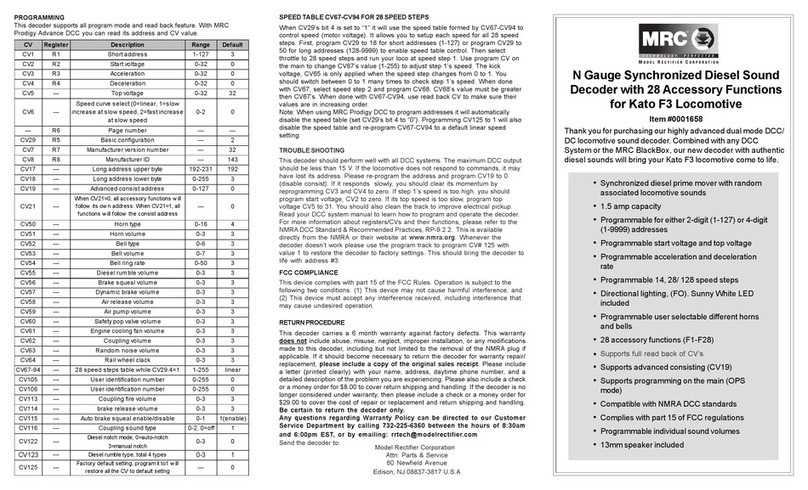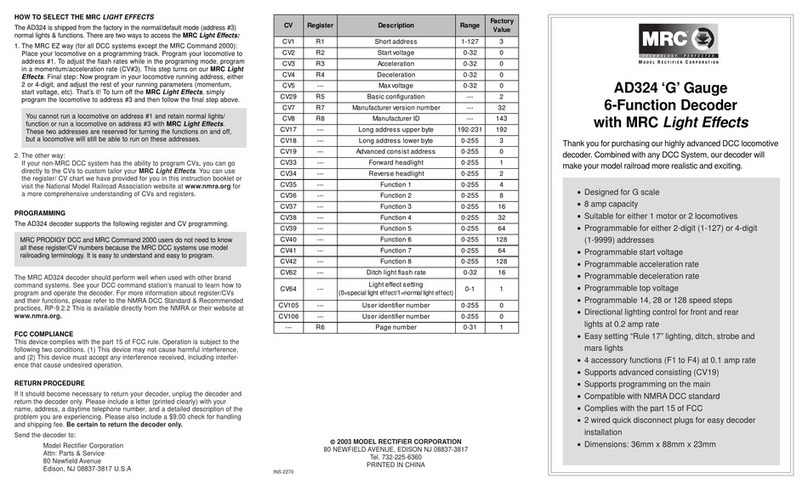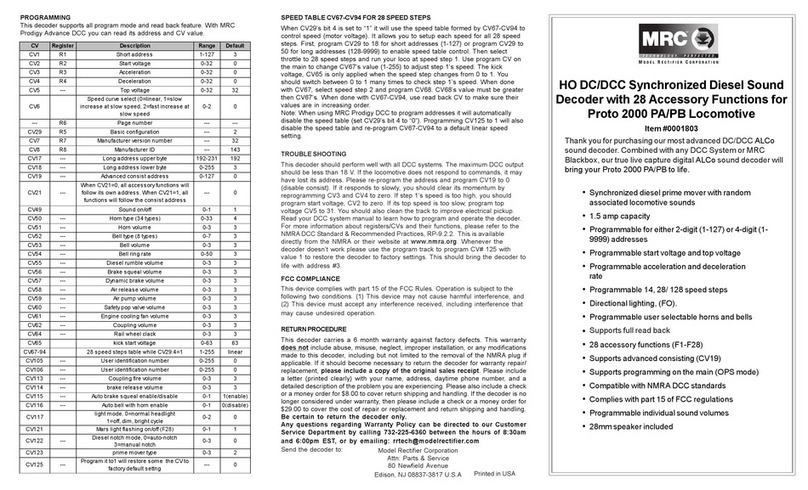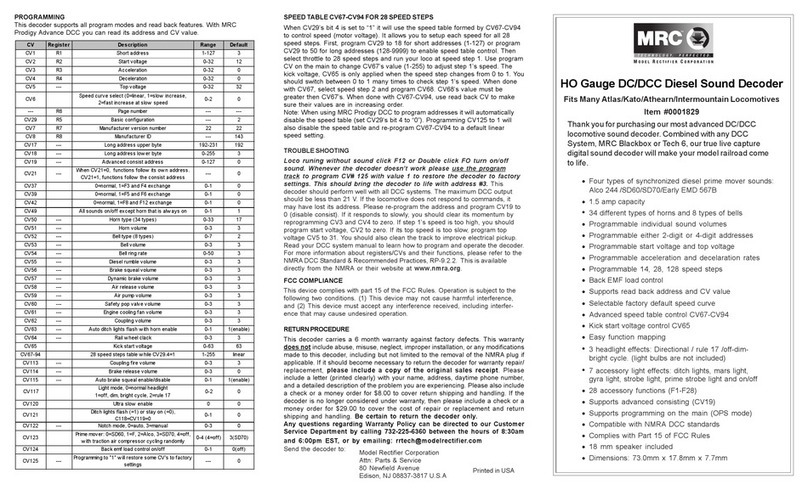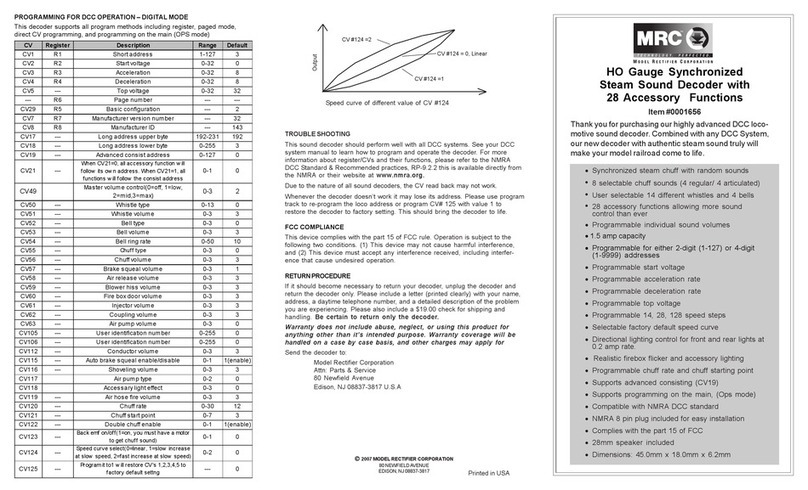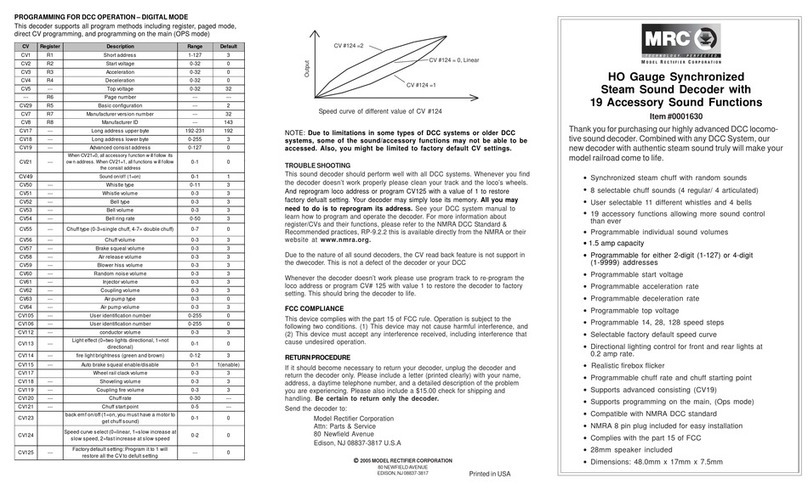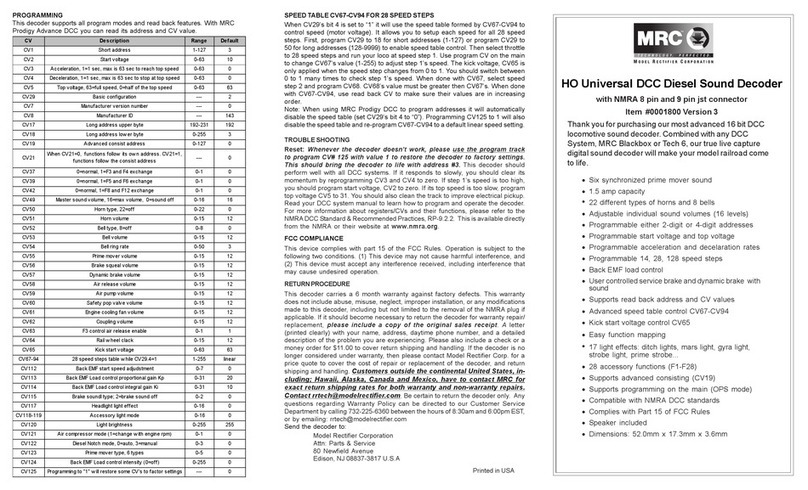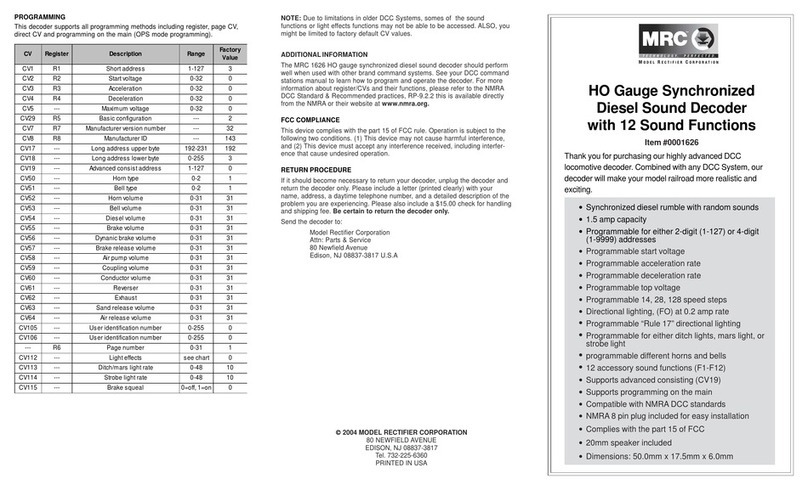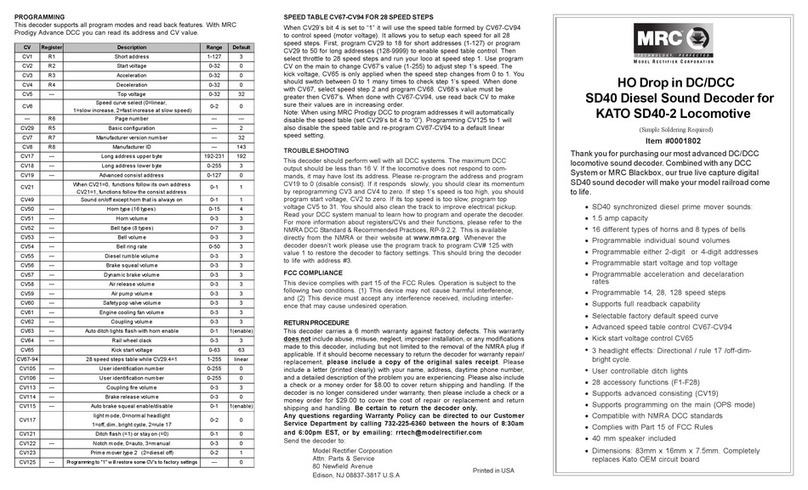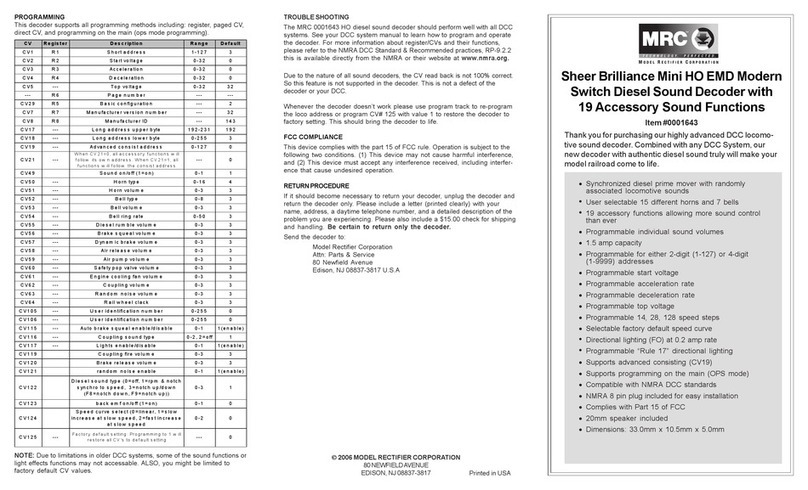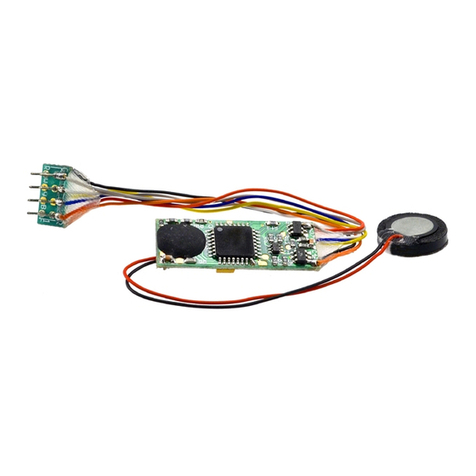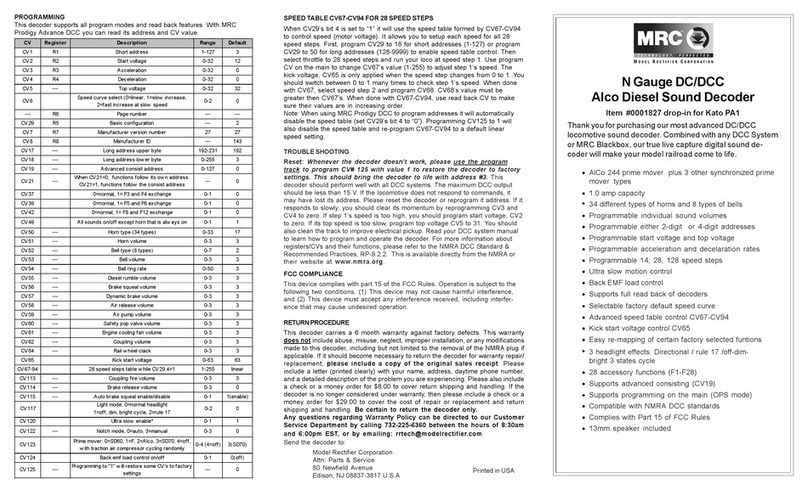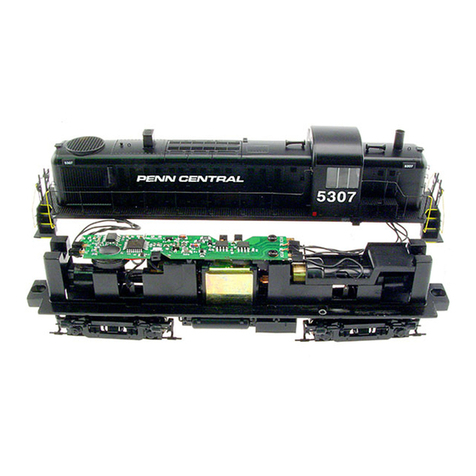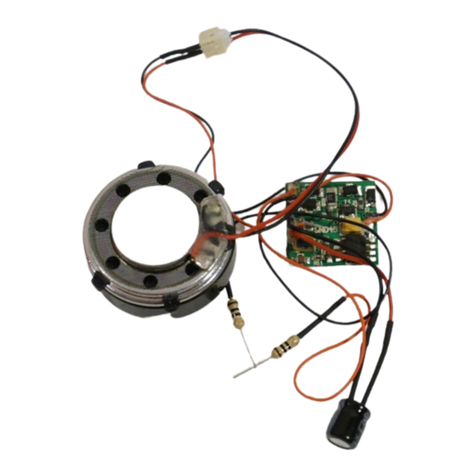
SPEAKER PLACEMENT
Your AD370 HO scale diesel sound decoder comes with a speaker rated at 8 ohms.
Placement of the speaker is up to you.
Use hot glue to affix the speaker to the locomotive.
MAKE A TEST TRACK
Before you start with your decoder installation, we strongly recommend building a
test track that uses a 20-ohm resistor to limit current. Only test your installed
decoder on the test track. The test track will prevent any damage due to an
incorrectly wired decoder. Figure 3. Diagram of test track
TEST
All MRC decoders have been factory programmed with address #3, 28/128
speed steps and maximum top voltage. After you have finished your decoder
installation, you are ready to test it. Never run the installed decoder on your
layout without first passing the test. You may damage the decoder if it is not
wired correctly or if you have not properly isolated the motor and the lights.
Put the loco on the test track. Select the Run Mode of your DCC system and
select or acquire address #3. Move up throttle and the loco should move
forward. Push the light button and the front light of your loco should turn on.
Push the reverse direction button. The loco should move backward and the
rear light should turn on. The loco cannot get normal speed because there is a
20-ohm protection resistor in the test track. If you are able to turn on/off the
front and rear lights and you are able to move the loco forward and reverse,
you did a great job. Congratulations! Do not test the loco on the test track
for an extended period of time. To do so will cause the protection resistor
to overheat.
If your installed decoder does not pass the test, find the problem, correct it
and test it again. As long as you test the decoder on the test track there is
little chance of damaging your decoder. This is why making a test track is
so important.
OPERATION
The AD370 decoder can be operated with diesel idle and rumble turned on or
off. If your DCC system has an F8 button, you can use it to activate the engine
sound. Otherwise you must double click your headlight button (F0) to turn the
diesel idle rumble on or off. When the diesel idle and rumble are turned off,
your bell, long horn, short horn and uncoupling sounds can still be activated by
using the appropriate function buttons (F1-F4).
The sounds of the AD370 are also active regardless of which mode you
program the decoder to: (Normal light/functions mode or MRC Light Effects
mode).
The AD370 decoder can be operated in either one of two ways:
1. Normal light/functions:
Headlights are directional and are controlled by your DCC system’s light
button (F0). Decoder functions (accessory lights) are normal on/off
controlled by F1-F3 buttons. Sounds will also be activated at the same time
with the pressing of these buttons.
2. MRC Light Effects:
A.“Rule 17” directional headlights: Headlights on/off (F0) light button. One
light is bright to indicate direction of travel and the other is dim. Also in
this mode, the (F0) light button turns on the strobe light if hooked up.
Normal headlight wiring is used for “Rule 17” lighting (white, yellow & blue
common wire).
B.Ditch lights: Use of the long horn (F2) or short horn (F3) buttons will
activate ditch lights with horn sounds. Ditch lights will flash 5 times after
horn sound ceases. If your DCC system has an F5 button, you can use it
to turn ditch lights steady on/off. Otherwise you must use the uncoupling
button (F4) to turn ditch lights steady on/off. When horn is activated, the
ditch lights will flash. To wire ditch lights, use green and purple accessory
wires with blue (headlight) common wire.
C.Strobe light: This light simulates the rooftop strobe light on some
locomotives. In the MRC Light Effects mode, the strobe will flash when
“Rule 17” headlights are on regardless of loco direction. To wire strobe
light, use brown accessory wire with blue (headlight) common wire.
INSTALLATION
It is quite a challenge to install a decoder into a locomotive. You should have some
basic electrical knowledge and soldering skills. If you do not have the above
requirements, please ask the dealer for help in installation.
Figure 1 shows the electrical circuit of most standard locomotives. The terminals of
the motor and light(s) are directly connected to the wheel pick-ups. Each type of
loco has its own method of electrical pick-up and distribution. The connection
between the wheels, motor and light(s) could be wires, clips, the body or chassis, a
PC board or any other type of conductor. Figure out your loco’s electrical system
and how to disconnect (isolate) the motor and light(s).
Figure 1. Connection of standard locomotive. Note: The ‘X’ marks indicate
where to disconnect (isolate).
The decoder will be inserted between the wheel pick-ups and the motor. The ‘X’
marks in Figure 1 show you where to disconnect (isolate).
Figure 2 shows you how to wire the decoder. After disconnecting the motor
terminals from pick-ups, connect the red wire to the right side pickup and the black
wire to the left side pick up. Connect the orange wire to the motor terminal that
originally connected to the right pickup. Connect the gray wire to the motor’s other
terminal. Connect the front light to the blue wire and the white wire. Connect the
rear light to the blue wire and the yellow wire.
The blue wire is the common terminal for lights and accessory functions. You may
use the black wire or the red wire to replace the blue wire. This is very useful when
you find that it is hard to isolate one of the light terminals from the pickup. Wiring
the bulb this way will also make the light dimmer. If your loco has only a front light,
you should connect the white and the yellow wires together.
Right side pickup
Front
light Motor Rear
light
Left side pickup
X X
X X X
X
Figure 2. AD370 wiring diagram
DCC base unit
Power supply
Test track
20 ohm resistor












